Our Tests Show Not All Ryzen 3000 Cores Are Created Equal
Previous-Gen Ryzen, Testing 3000-Series Without the Ryzen-Aware Scheduler
How Do Zen and Zen+ Perform?
We've determined there are faster and slower cores on the Ryzen 3000-series processors, but why does that matter? It denotes a shift in AMD's chip binning practices and what the company deems as fit for shipping. That means we need to see how the company handled its binning with prior-gen chips.





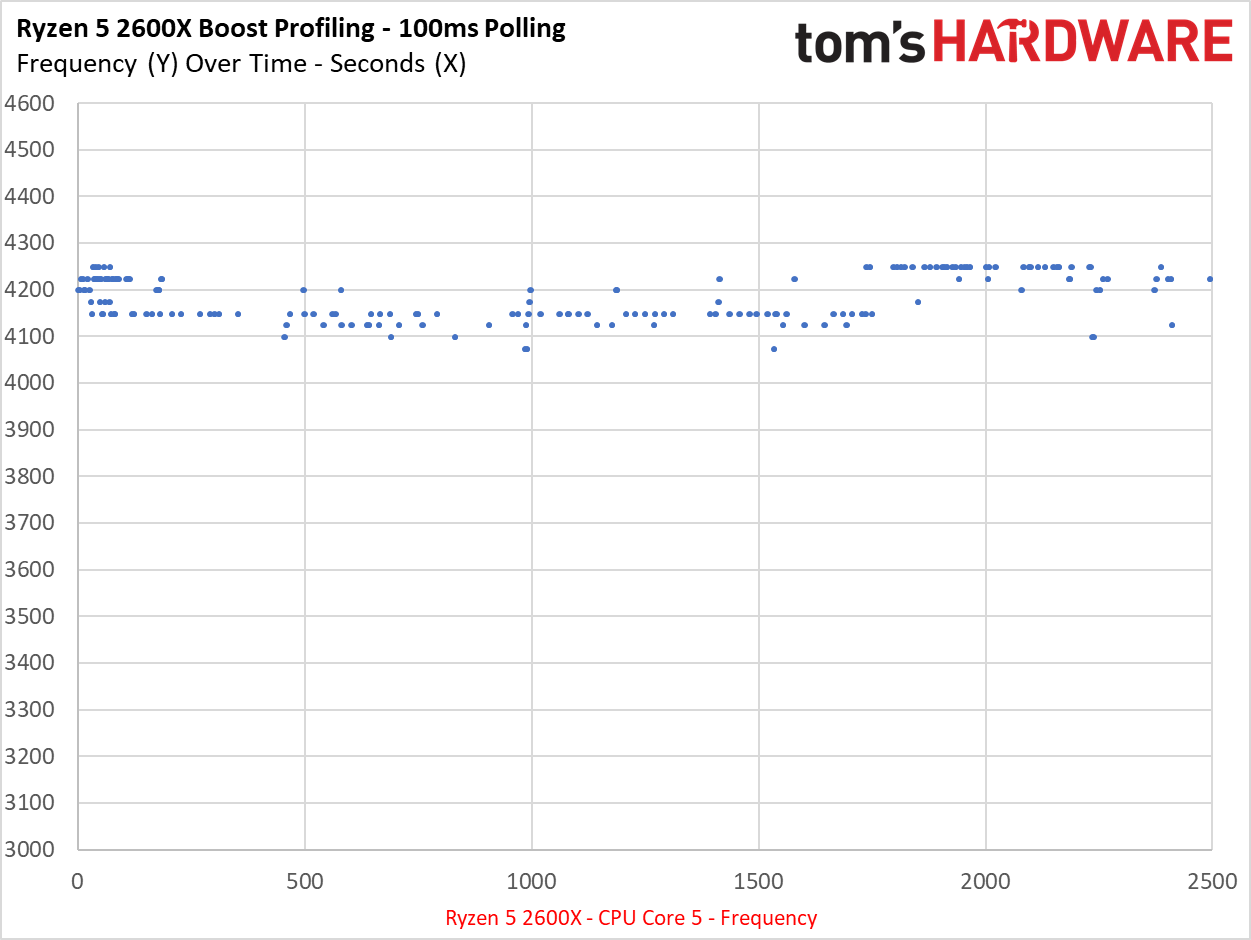

We tested the Ryzen 5 2600X, the 3600X's prior-gen counterpart, which all cores active, on the latest revision of Windows. As you can see, all cores, at one point or another, reach this chip's 4.2 GHz boost clock. In fact, they often exceed that rating due to the company's XFR2 (eXtended Frequency Range) feature, which allows the chip to boost even higher if it is equipped with beefy power delivery and cooling solutions.
AMD doesn't specify an XFR2 ceiling, but we can see that the chip reaches up to 4.25 GHz on any given core.





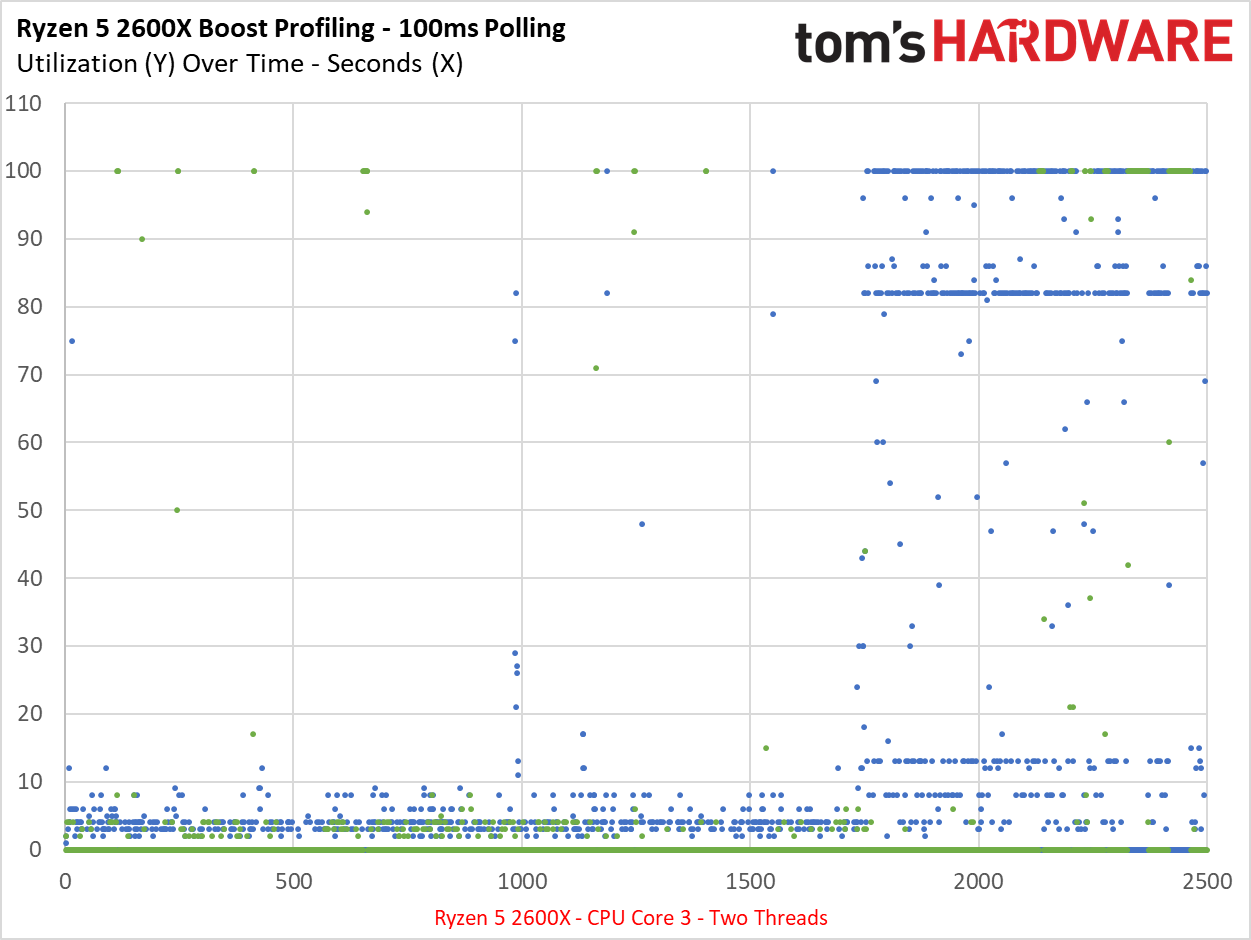

Here we plot the utilization of each core on the previous-gen Ryzen, and we can see that the workloads move around seemingly at random, just like we have been trained to expect given the past decade of multiple core processors: every CPU core should theoretically hit the turbo frequency.
This is most pronounced during the early stages of our benchmark, where the five ~35-second LAME benchmarks are assigned to different cores without any apparent targeting to maximize boost clock rates. Although the CPPC2 feature is included in our chipset drivers and the Ryzen-aware scheduler is also present, it doesn't appear to impact first-gen Ryzen chips in regards to thread targeting.
Testing Ryzen 5 3600X Without the Ryzen-Aware Scheduler
Finally, to see how important the impact of the combination of the new Ryzen-aware scheduler and CPCC2 features are, we tested the current-gen Ryzen 5 3600X with Windows 10 1703. We do have the CPPC2 drivers installed via the chipset driver package, but it appears thread targeting doesn't function as efficiently without the new scheduler directing traffic.






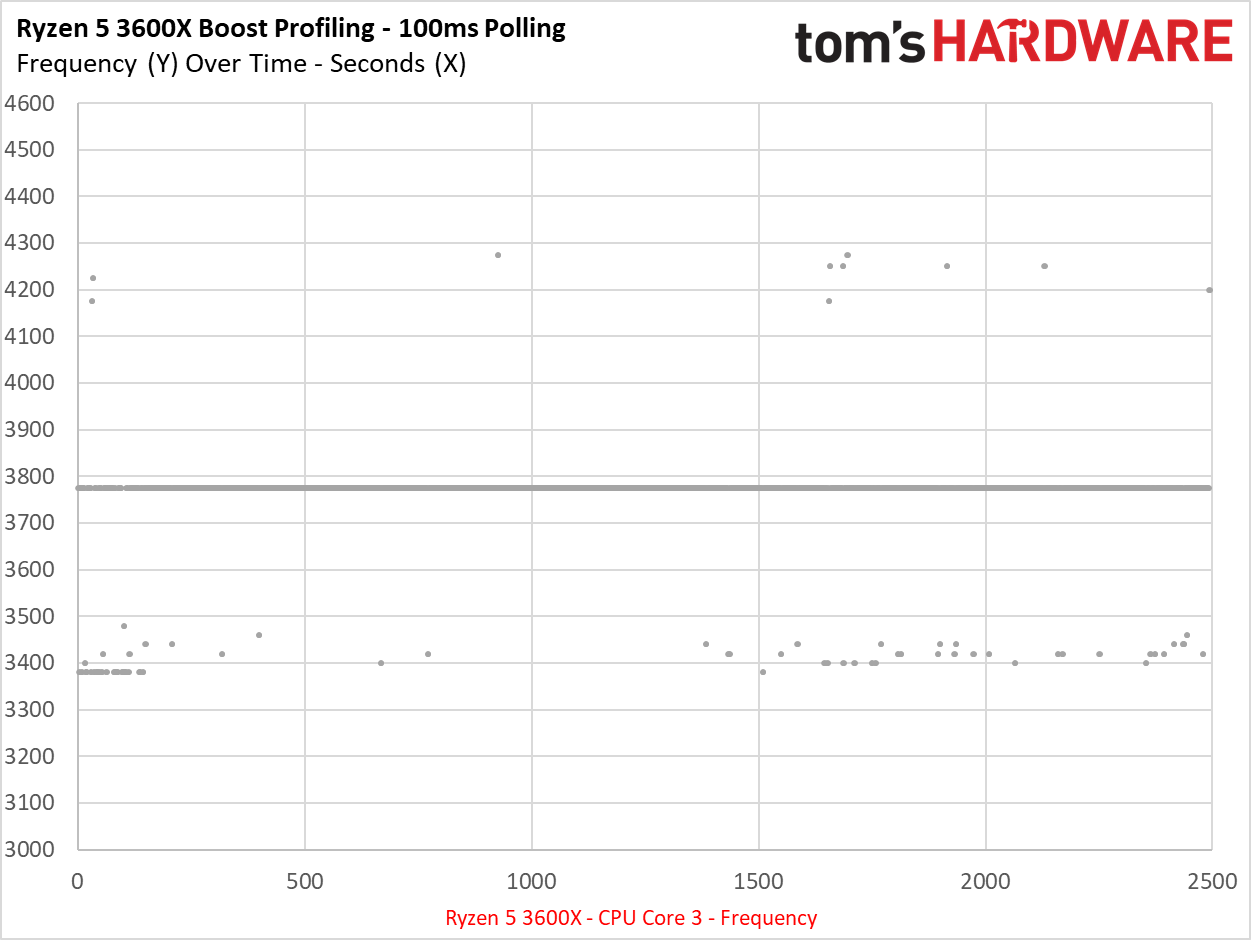
The workloads move among the cores, but in a limited fashion. Core 2, Core 4, and Core 6 yield measurements above 4.3 GHz.
Get Tom's Hardware's best news and in-depth reviews, straight to your inbox.

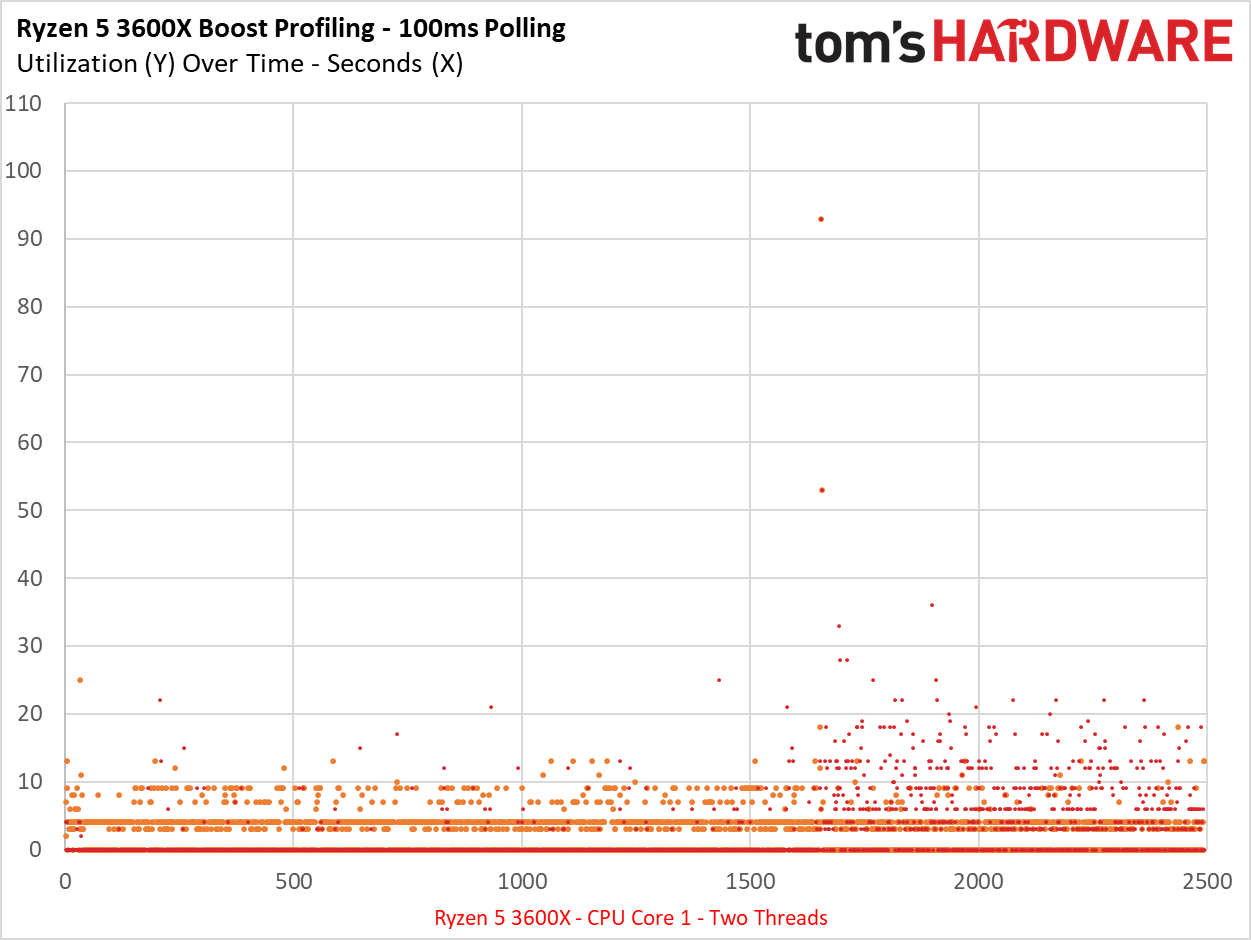



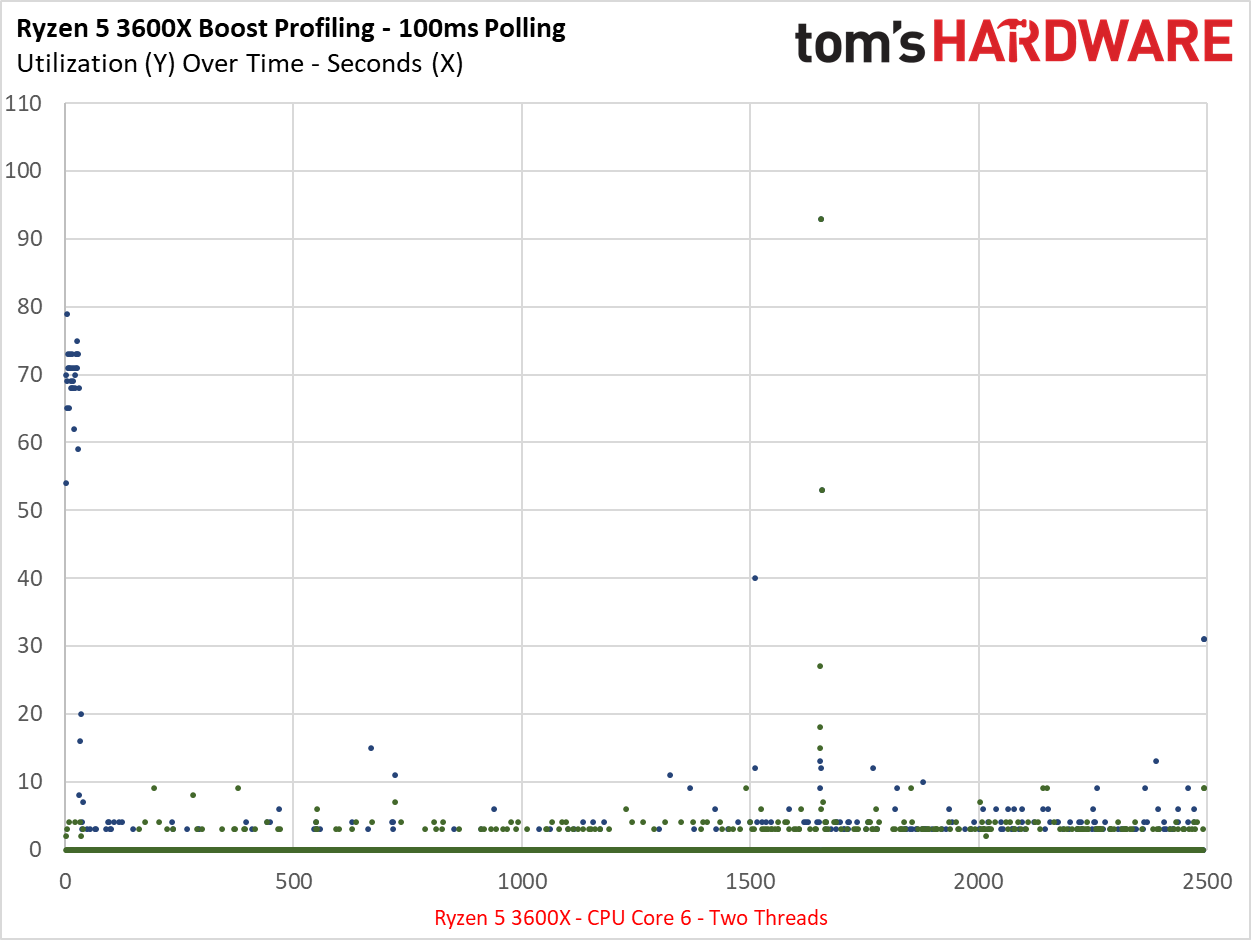

Surprisingly, Core 5 takes the brunt of the workload even though it doesn't have the highest boost capability. As we have seen in the prior album of charts, that core largely sticks at a 4.25 GHz clock rate but has peaks of 4.3 GHz. In either case, Core 4 has a boost of 4.35 GHz, indicating it is the faster core, but the workload isn't landing in that core.
That illustrates that the combination of the new scheduler and CPPC2 is a clever implementation to get the most out of the silicon, but it also means that enthusiasts measuring clock rates with older versions of Windows, or without the correct chipset drivers installed, will see reduced performance. It also explains why some are not seeing the peak clock speeds during some workloads.
MORE: Best CPUs
MORE: Intel & AMD Processor Hierarchy
MORE: All CPUs Content
Current page: Previous-Gen Ryzen, Testing 3000-Series Without the Ryzen-Aware Scheduler
Prev Page Disabling the 3600X's Fastest Cores Next Page Thoughts
Paul Alcorn is the Editor-in-Chief for Tom's Hardware US. He also writes news and reviews on CPUs, storage, and enterprise hardware.
-
rhysiam Really interesting article Paul and team, thanks!Reply
IMHO this is a case of clever engineering mixed that's been muddied by dubious (at best!) marketing. Intel's approach of specifying both Turbo Boost 2 (which all cores can meet) and Turbo Boost 3 (the highest possible clock speed on any single core) is a more transparent approach and one that AMD should adopt.
As you suggest, AMD likely have binning requirements on the "worst" cores, but these should be included in the spec table for the CPU. We should know what they are. On Z390 motherboards you can flick an "MCE" switch and it just works (provided you can cool it), because Intel have a minimum frequency that each individual core must be able to hit. That's the way it should be.
Intel have work to do around transparency too: their stupidly low base clocks and lack of transparency around dual + quad core boost frequencies is similarly misleading at best. But on the issue of this article, AMD should be more open. AMD's response quoted in this article is totally inadequate. Hopefully you gain some traction and they decide to give you more than "blah blah blah meet the product definition". -
AlistairAB Wow this is fantastic work. I'm back to loving Tom's again. Remember Paul Alcorn ;)Reply -
TJ Hooker Something to keep in mind is that some Intel CPUs may fail to hit their max turbo speeds as well, albeit for different reasons. Intel is more specific about what the max turbo is for a given number of cores loaded, and some CPUs will only hit their max speed on a single core. The prevailing theory seems to be that with a typical system there will always be stuff going on in the background, such that there's never truly only one core being loaded, and therefore you may never actually see the single core turbo speed.Reply
I know my 6700k won't hit 4.2 GHz at stock settings running benchmarks like P95 or Cinebench single threaded. -
AlexTSG Interesting reading this just a few days after the Silicon Lottery binning results.Reply
Given that AMD wants to use as much of the silicon they produce as possible, I wonder if we'll see 6 and 8 core processors that utilize two processor chiplets, where only 3 or 4 of the cores are active.
I'm planning on building a new Ryzen 3000 system towards the end of the year, so I'm hoping that another 6 months sees some improvements made to the 7nm process, and possibly new processor steppings. -
rhysiam Reply
That's interesting, I wasn't aware there were regular issues on Intel's side too.TJ Hooker said:Something to keep in mind is that some Intel CPUs fail to hit their max turbo speeds as well, albeit for different reasons. Intel is more specific about what the max turbo is for a given number of cores loaded, and some CPUs will only hit their max speed on a single core. The prevailing theory seems to be that with a typical system there will always be stuff going on in the background, such that there's never truly only one core being loaded, and therefore you may never actually see the single core turbo speed.
I know my 6700k won't hit 4.2 GHz at stock settings running benchmarks like P95 or Cinebench single threaded.
To be fair though, presumably you can just flick the MCE switch (or equivalent) in your BIOS and, assuming you have a capable motherboard and cooler, you should hit 4.2Ghz on all cores? In other words, all four cores should be capable of sustaining 4.2Ghz at ambient-coolable voltages. That's simply not the case with the new Ryzen processors.
I like where AMD are going with Ryzen and I'm saving my pennies for a 3900X, but I'm glad these boost scenarios are being explored and I hope they are more transparent with future releases. -
UncleElias Replyadmin said:Not to mention the 12-core Ryzen 9 3950X. We'll certainly be busy at our test benches.
Typo?
I'm looking forward to your testing of the 12 core 3900X and 16 core To be released 3950X. -
mdd1963 "not all cores can reach the advertised boost frequency'?Reply
That's a pretty big understatement...
It seems lucky for many users if even the best single core can hit only 50-100 MHz below it....for 1/4 second or so...and many seemingly are lucky to achieve even 100 MHz below it...
All core? Most definitely, subtract 200-300 MHz...maybe 400 MHz...
I'd not be surprised to eventually see some 'class-action' activity involving attorneys, frankly...; I don't think AMD's little 'you need to understand' sponsored lectures really help much. -
redgarl Okay, the CPU have been released for a mere 3 weeks. How do we know it is not related to BIOSes? You lost all credibility with Just Buy It!Reply -
greenreaper Reply
It's more likely we'll see those put into Athlon as single chiplets, although what you envisage could be suitable for low-end EPYC designed for storage servers. Ryzen isn't the high-end brand, but it's also not the low-end.AlexTSG said:Gen that AMD wants to use as much of the silicon they produce as possible, I wonder if we'll see 6 and 8 core processors that utilize two processor chiplets, where only 3 or 4 of the cores are active.
Of course, they could do Athlon as a no-graphics derivative of the Zen 2 APU instead, which may be a monolithic integrated design, sans chiplets, as in Zen 1. -
13thmonkey Will this improve with time? Will next year's chips behave differently, given how close to the edge they are perhaps they will. Intel have sufficient headroom that you may not notice any beneficial drift, other than in the most extreme of max OC'sReply